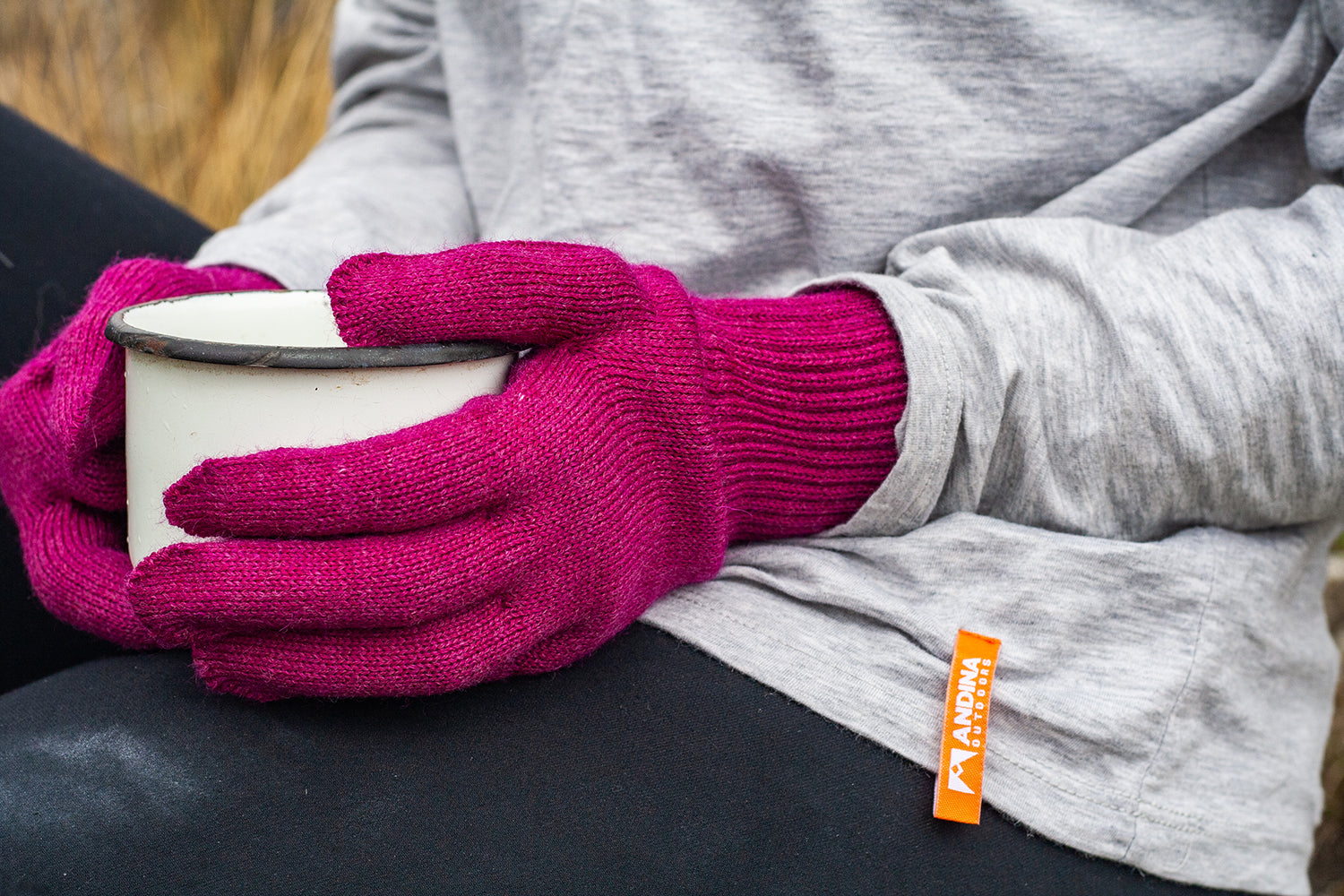When planning a winter adventure, your gear can make or break your experience. Whether you're backpacking through snowy trails or setting up camp in frosty forests, cold weather camping clothes must provide more than just warmth—they need to regulate moisture, allow freedom of movement, and stand up to the elements over multiple days of use.
In this guide, we explore the best fabrics for cold weather camping, comparing natural and synthetic options, and helping you build the ultimate winter layering system. From alpaca wool camping clothes to breathable winter camping gear, here’s everything you need to know before your next chilly expedition.

Why Fabric Choice Matters for Cold Weather Camping
Your body’s ability to stay warm while camping in the cold depends heavily on what you're wearing. The best cold weather hiking clothes should insulate you from the cold, wick away moisture, and allow breathability. Choosing the right thermal clothing for camping ensures you stay dry, warm, and agile even in unpredictable weather.
Layering the right fabrics can protect you from dangerous cold exposure, prevent excessive sweating, and make your overall experience far more comfortable. A good outfit is not just about insulation—it’s about thermal balance, moisture management, and reliable durability.
Let’s break down the core functions of winter camping fabrics:
- Insulation: Traps body heat to keep you warm.
- Moisture-Wicking: Pulls sweat away from the skin to prevent dampness.
- Breathability: Allows airflow to prevent overheating and excessive perspiration.
- Durability: Resists abrasion and wear from rugged terrain.
- Comfort: Provides softness, stretch, and flexibility for active movement.

The Best Fabrics for Cold Weather Camping Clothes
1. Merino Wool: The Natural All-Star
Merino wool camping clothes are a gold standard for both base and mid layers. This natural fiber is ultra-soft, moisture-wicking, temperature-regulating, and odor-resistant—making it ideal for multi-day camping trips where performance and hygiene matter.
- Excellent warmth-to-weight ratio
- Maintains insulation even when wet
- Naturally breathable and antimicrobial
Use for: Base layers, socks, thermal tops, beanies, glove liners
Its only downside is that it may wear out more quickly in high-abrasion areas and may require careful washing. Still, for comfort, breathability, and reliable warmth, merino remains a favorite among outdoor enthusiasts.
2. Alpaca Wool: Sustainable, Superior Insulation
Alpaca wool camping clothes are quickly becoming the fabric of choice for sustainable adventurers. Known for its silky texture and incredible warmth, alpaca fiber is naturally hypoallergenic, water-resistant, and warmer than traditional wool by weight.
- Hollow-core fibers provide exceptional insulation
- Naturally repels water, wind, and odor
- More eco-friendly than many other natural fibers
Use for: Cold weather base layers, scarves, sweaters, insulating jackets
Unlike other wools, alpaca is less itchy and doesn’t contain lanolin, making it ideal for sensitive skin. For those seeking ethically sourced, high-performance gear, brands like Andina Outdoors offer expertly crafted alpaca layers that balance function and sustainability.
3. Synthetic Insulation: Lightweight and Fast-Drying
When considering synthetic vs natural camping fabrics, synthetics like polyester, nylon, and elastane are engineered for performance. These materials dominate the market for moisture-wicking camping clothes and excel in high-output activities such as alpine hiking or snowshoeing.
- Best used as mid-layers or protective shells
- Excellent for fast-paced activities in wet or snowy conditions
- Quick-drying and easy to care for
Use for: Jackets, leggings, thermal tops, glove liners, outer shells
Though synthetics lack the sustainability and long-term odor resistance of natural fibers, their versatility, affordability, and weather resistance make them indispensable in a cold-weather layering system.
4. Fleece: Lightweight Warmth and Comfort
Fleece is a synthetic fabric made primarily from polyester, often incorporating recycled materials. It is praised for being soft, breathable, and insulating without adding significant bulk.
- Highly breathable and quick-drying
- Excellent for layering in cold but dry conditions
- Available in a range of thicknesses (microfleece to heavyweight)
Use for: Mid-layers, light jackets, pajamas, sleeping attire
Fleece doesn’t retain moisture and dries quickly, but it offers less wind resistance than wool. When paired with a protective outer layer, it becomes an essential part of your winter layering system.

Fleece vs Wool Camping Clothes: Which to Choose?
| Feature | Fleece | Wool (Merino/Alpaca) |
|---|---|---|
| Warmth | Good | Excellent |
| Moisture-Wicking | High | High |
| Odor Resistance | Low | High |
| Eco-Friendly | Varies | High (especially alpaca) |
| Care | Machine washable | Requires gentle care |
If you’re seeking comfort with easy maintenance, fleece is a winner. But for extended adventures or sustainability-driven packing, alpaca wool camping clothes deliver unmatched performance.
Building the Perfect Layering System
Crafting a smart clothing system is essential for winter camping. Each layer plays a role in your comfort, warmth, and adaptability. Here’s how to structure your winter gear using the best outdoor clothing materials:
Base Layer: Moisture Management
- Material: Merino or alpaca wool, high-performance synthetics
- Function: Wicks sweat, keeps skin dry, regulates temperature
- Example: Thermal shirts, fitted leggings, wool socks
Mid Layer: Thermal Insulation
- Material: Fleece, alpaca wool, synthetic down or fill
- Function: Traps heat close to the body
- Example: Puffers, pullovers, wool sweaters
Outer Layer: Element Protection
- Material: Waterproof synthetics, technical hybrid fabrics
- Function: Shields from wind, snow, and rain
- Example: Hard shell jackets, snow pants, parkas
For optimal performance, make sure each layer is compatible and allows for range of motion. Good gear should move with you—not restrict you.

Bonus Features to Look For in Winter Camping Clothes
- Moisture-Wicking Performance – Stay dry from the inside out
- Wind & Water Resistance – For rain, snow, and gusts
- Stretch & Mobility – Crucial for hiking and climbing
- Sustainability – Support eco-conscious fabrics like alpaca and recycled synthetics
- Layer Compatibility – Designed to work as a system, not just standalone pieces
Conclusion: Choose Smart, Stay Warm
Whether you're planning a weekend in the Rockies or a weeklong trek through the backcountry, investing in high-performance cold weather camping clothes is essential. The best materials—alpaca wool, merino wool, synthetic insulation, and fleece—each bring unique advantages to your winter kit.
At Andina Outdoors, we believe your gear should support both your performance and your principles. That’s why our curated collection of sustainable alpaca layers, outerwear, and accessories is designed to keep you warm without compromising the planet. Choose better fabrics. Camp smarter. Stay warm.


